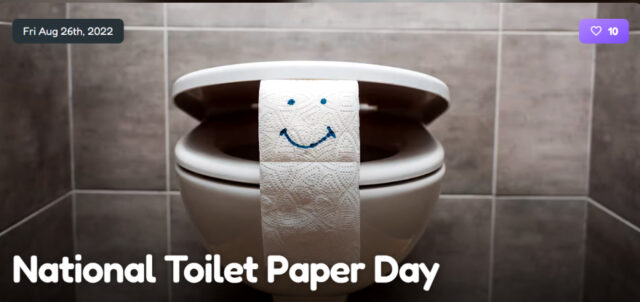
Throughout human history, people have made use of all sorts of different creative ways to take care of their personal toilet hygiene. Items of nature have certainly been part of the list, including leaves, corn cobs, and even sponges that were attached to a long stick and used communally.
- Toilet paper began its wide use in China by the 6th century.
- By the 14th century, the Chinese had made advancements in toilet care, producing packages of special paper people could use in their wiping endeavors.
- It is estimated that the culture produced at least 10 million packages of toilet paper each year!
- During this time in China, royalty had access to special toilet paper. In 1391, the toilet paper that was made for the emperor had each sheet specially perfumed.
- During the 18th century, when newspapers and magazines arrived on the scene in the West, these were often read and then re-purposed for use in the outhouse or Water Closet (WC).
- The Sears catalog and the Farmer’s Almanac were two legendary forms of paper that eventually ended up in the toilet. The story goes that Farmer’s Almanac began pre-drilling holes into the tops of their books in 1919, to allow people to easily hang them from the walls of their outhouses.
- Joseph Gayetty of New York began the production of what he called “Medicated Paper for the Water Closet”. Gayetty is credited with the invention of modern toilet paper
- Toilet paper was first produced in stacks of sheets and available commercially in New York City in 1857.
- Gayetty’s toilet paper was made of pure Manila hemp paper, with each sheet watermarked as “J C Gayetty N Y”.
- Originally, Gayetty marketed his product for medical purposes, as it contained aloe and was advertised as an anti-hemorrhoid product.
- Gayetty would sell his toilet paper for a dollar per 1,000 sheets. However, his product did not take off.
- By the end of the 19th century, toilet paper began appearing in perforated rolls which made it more convenient for people to use. Companies began advertising their toilet paper as being “splinter-free”.
- The Scott brothers founded the Scott Paper Company in 1879 and it started selling toilet paper in rolls in 1890.
- One person’s lifetime usage of toilet paper, if made from virgin paper, would take around 384 trees to make! Of course, using toilet paper that has been recycled from other purposes helps to cut down on this extensively.
- In the 1950s, colored toilet paper was popular because it was considered to be a cool decorating hack to “match” the pastel color of the toilet paper to the bathroom decor. However, when it was learned that the dyes in the toilet paper were perhaps not hygienic as well as possibly harming the environment. The last company to discontinue this practice in the US was Scott in 2004.
- Toilet paper has been made from all kinds of things, including gold. One manufacturer makes toilet paper out of 22-carat gold with one roll costing more than $1,300,000. This is the equivalent of literally flushing money down the toilet!
- About four billion people don’t use toilet paper. About 70% – 75 % of the world’s population does not use toilet paper.
- Toilet paper has secondary uses such as nose care, removing makeup, covering toilet seats, packaging material, cleaning mirrors, cleaning glasses, etc.
- Two-ply toilet paper consists of two layers of 10 thickness paper, one ply is made of a 13 thickness paper, and so, two-ply is not necessarily twice the thickness.
- In an average household, the average roll of toilet paper lasts approximately five days.
- Consumers use approximately 8 – 9 sheets of paper per toilet use.
- We use an average of 57 sheets of toilet paper a day!
- Seven percent of Americans steal rolls of toilet paper in hotels or motels.
- The U.S. ranks as the top country that consumes toilet paper. Its per capita average is nearly 3 rolls per week.
- If you hang your toilet paper so you can pull it from the bottom, you’re deemed to be more intelligent than someone who hangs their toilet paper and pulls it from the top.
- This toilet paper patent solved the debate on the proper way to hang the roll. Seth Wheeler patented rolled and perforated toilet paper on December 22, 1891. The patent’s illustration confirmed that toilet paper must go up and over.
- The average person uses 100 rolls of toilet paper per year (over 20,000 sheets).
- The daily production of toilet paper is about 83,048,116 rolls per day.
- The average toilet paper roll consists of 333 sheets.
Sources:













[…] The Average Person Uses 100 Rolls Of Toilet Paper Per Year – If you hang your toilet paper so you can pull it from the bottom, you’re deemed to be more intelligent than someone who hangs. […]